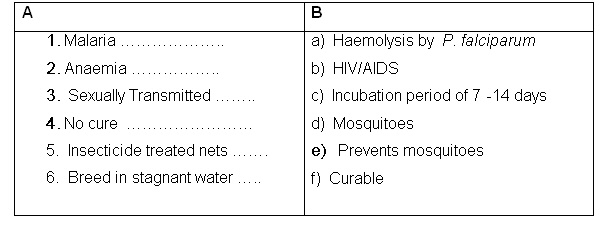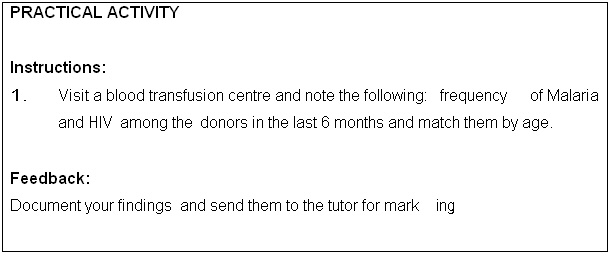Lesson 10: HIV/AIDS And Malaria
Contents
INTRODUCTION
In the early 1980s, a new pandemic emerged known as Acquired Immunodeficiency Syndrome (AIDS). It is caused by infection with the Human Immunodeficiency Virus (HIV). According to AIDS epidemic update of 2004 by WHO an estimated 40 million people are living with HIV worldwide, including 2.5 million children under the age of 15 years. Globally in 2003, an estimated 5 million people were newly infected and 3 million people died of AIDS. The Sub-Saharan Africa region is the worst affected, with 90% of cases and deaths occurring in this region. The effects of HIV/AIDS are widespread ranging from health to socio-economic. A great majority of those infected are people in the reproductive and economically productive age group of 15 – 45 years. It is estimated that by 2010, over 40 million people worldwide shall be infected or living with HIV/AIDS.
For example in Kenya, WHO HIV indicators in 2003 showed that an estimated 820,000 to 1.7 million people were living with HIV/AIDS. An estimated 1.5 million people have died from HIV/AIDS in Kenya since 1984. There are millions of children infected and many more orphaned by HIV/AIDS.
The distribution of HIV/AIDS in Africa seems to follow the following pattern:
- It is common in towns situated along main lines of transport, communication and business areas;
- Vertical transmission is the main route of infection among children.
Both Malaria and HIV/AIDS are major health problems in Africa. The chance of meeting a person who is suffering from both the diseases is common because of the high prevalence of both illnesses in the community. In cases co-infection there is a tendency for HIV/AIDS to influence malaria at least in its frequency, persistence and severity.
We do appreciate that so far not much has been done to link the two major illnesses together. However, research is ongoing and some of the findings coming from it have revealed that there is a certain trend of events which occur when the two illness are found in the same person. Often, in such cases there is an increased risk of a person suffering from HIV/AIDS getting Malaria.
|
By the end of this unit you should be able to:
|
|
HIV is acronym for Human Immuno deficiency Virus. A person infected with HIV virus develops specific anti-bodies towards the infection. HIV Antibodies are commonly used in testing HIV infection. A person infected with HIV can remain asymptomatic for a long time before developing AIDS. AIDS is an acronym for Acquired immune deficiency syndrome. HIV positive person is said to AIDS when the signs and symptoms of the disease appear. These may include the presence of opportunistic infections such as: oral candidiasis, toxoplasmosis and other disease such as recurrent pneumonias, pneumocystis carinii pneumonia, Tuberculosis etc. |
Having defined HIV/AIDS, let us now learn the mode of transmission of HIV/AIDS in the population.
Mode of Transmission of HIV/AIDS.
HIV/AIDS is transmitted through the following ways:
- Sexual intercourse with an infected person (both hetero/homo sexuality) other antisocial acts such as rape, defilement increase the risk of infection.
- Transfusion with HIV infected blood OR blood products
- Mother to child transmission (vertical transmission);
- Cuts or pricks with tools contaminated with blood or blood products from a person with HIV, such as may occur in circumcision, tattooing, skin cutting, injection pricks etc.
HIV is known to be in high concentration in the following body fluids:
- Blood;
- Cerebro spinal fluid (CSF);
- Cervical/vaginal secretion;
- Semen;
- Wound fluids.
We have so far learnt the mode of transmission of HIV/AIDS. We shall now turn to common issues and interaction between HIV/AIDS and Malaria.
Similarities between HIV/AIDS and Malaria.
It is now evident that both HIV/AIDS and Malaria are common major health problems in Africa. As we mentioned earlier it is common practice to diagnose Malaria and HIV/AIDS in the same person.
Before you read on, do Activity 1, it should take you 5 minutes to complete.
| 1
From your experience and what you know about Malaria and HIV/AIDS, what are the similarities between the two diseases? …………………………………………………………………………………………… …………………………………………………………………………………………… …………………………………………………………………………………………… …………………………………………………………………………………………… …………………………………………………………………………………………… …………………………………………………………………………………………… …………………………………………………………………………………………… …………………………………………………………………………………………… …………………………………………………………………………………………… ……………………………………………………………………………………………
|
We hope you have noticed that the similarities mainly revolve around the disease burden, transmission, clinical presentation and the socio-economic impact of these diseases.
Some of the similarities are that both diseases are:
- Transmitted by blood or blood products for example during blood transfusion;
- Among top five killer diseases in Africa;
- Present with fever;
- Sometimes may present with splenomegaly;
- A burden to our socio economic sector in terms of treatment and prevention cost as well as direct interference with service delivery;
- Transmissible through the mother-to-child route.
Having learnt about the similarities of the two diseases, let us now turn to the signs and symptoms of HIV/AIDS.
Signs and Symptoms of HIV/AIDS
Some of the signs and symptoms of HIV/AIDS include
- Weight loss of over 10% especially in adults;
- Failure to thrive in children;
- Chronic diarrhoea for more than 1 month;
- Chronic fever for more than 1 month;
- Generalised lymphadenopathy;
- Oral thrush;
- Repeated common infections;
- Extensive/generalised dermatitis;
- Enlarged liver and/or spleen.
We have so far learnt about the signs and symptoms of HIV/AIDS let us now turn to the interaction between Malaria and HIV/AIDS.
Interaction between Malaria - HIV/AIDS
Studies have shown that HIV/AIDS infection, a major problem in Africa, reduces resistance to Malaria and causes Malaria treatment to be less effective. HIV/AIDS infection during pregnancy predisposes the mother to increased risk to malaria related problems, irrespective of the parity.
In addition, HIV infected women have a much higher risk of giving birth to babies who have had Intra-uterine Growth Retardation (UGR). This leads to low birth weight and/or pre-term babies. These mothers may also suffer from anaemia.
Research has also shown that HIV infected mothers can infect their babies with HIV during pregnancy, at delivery and through breast-feeding. This process is called mother-to-child transmission (MTCT) of HIV/AIDS. Babies infected with HIV tend to have reduced resistance to Malaria.
Before you read on do Activity 2, it should take you 5 minutes to complete.
Now compare your answers with the ones given below and find out how well you faired.
1. f 5. e 2. a 6. d 3. b
4. b
CONCLUSION
We have now come to the end of unit 10. In this unit we discussed the relationship between malaria and HIV/AIDS. We saw that the interaction between malaria and HIV/AIDS seems to be a function of immunity. The lowered immunity of people suffering from HIV/AIDS reduces their resistance to Malaria.
You may wonder why we brought up this topic! There were two reasons: HIV/AIDS and Malaria may occur in the same person; and patients with HIV/AIDS may have recurrent malaria or persistent malaria, sometimes in the severe form.
Treatment of Malaria in HIV/AIDS patients follows same protocol as in general population.
Remember, research on the interaction between malaria and HIV/AIDS is still going on. So we encourage you to take an interest in these developments to stay up-to-date. If you attend seminars or conferences where this topic is being discussed ask questions relating to this subject. You may get the latest information from such occasions.
You should now go back and review the objectives we outlined at the beginning of this unit. If there is anything you are not sure about, read the relevant section again. If you feel confident you have achieved them all, complete the attached Tutor Marked Assignment before you proceed to the next unit. Remember to also do the practical activities outlined below and return your feedback to the tutor.
|
AMREF DIRECTORATE OF LEARNING SYSTEMS
Student Name __________________________________ Student Number:_________________________________ Student Postal Address: __________________________ __________________________
DISTANCE LEARNING COURSE ON MALARIA
………………………………………………………………………… …………………………………………………………………………
………………………………………………………………………… …………………………………………………………………………
If the answer is F. Give the current Policy in your country …………
Case_Study You receive a client who complains of headache and fever. He tells you that he is HIV positive and is attending follow up at nearby VCT Centre. You assess him and suspect that he has Malaria. Basing on the above information and your own experience answer the following questions: (i)What investigations would you do on him to exclude Malaria? ……………………………………………………………………………… ……………………………………………………………………………… ……………………………………………………………………………… ……………………………………………………………………………… ……………………………………………………………………………… ……………………………………………………………………………… ……………………………………………………………………………… ……………………………………………………………………………… (ii)If all the results show that he has no Malaria, what further investigations would you do and for what reasons? Investigation Reasons ………………………… ………………………………… ………………………… ………………………………… ………………………… ……………………………… ………………………… ………………………………… ………………………… ………………………………… ………………………… ………………………………… (iii)Assume that one of the investigations in (ii) above is positive, how would you manage him for this condition? ……………………………………………………………………………… ……………………………………………………………………………… ……………………………………………………………………………… ……………………………………………………………………………… ……………………………………………………………………………… ……………………………………………………………………………… Congratulations! You have come to the end of this assignment. If you experienced any problems in this unit or assignment write it down and send it to us. We shall be happy to give you relevant responses to enable you cope with the course. Post or bring this assignment in person to AMREF. We shall mark it and return it to you with our comments. Remember to clearly indicate your name and student number on the assignment. |
Enjoy the rest of the course!

